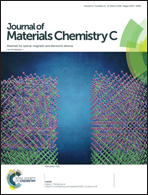Design of asymmetric benzodithiophene based wide band-gap conjugated polymers toward efficient polymer solar cells promoted by a low boiling point additive†
Abstract
In this work, we reported two wide band-gap donor–acceptor (D–A) photovoltaic materials based on asymmetric benzodithiophene units with a bare phenyl or alkoxyl chain modified phenyl group as one of the substitutions. The optical band-gaps of the two polymers are both identified above 1.80 eV. P2 (with a side chain in the phenyl group) reveals slightly red-shifted film absorption spectra compared to polymer P1 attached with the bare phenyl group, which is partly attributed to the better molecular conformations and intermolecular interactions. Polymer solar cells with different acceptor materials are fabricated to systematically evaluate the photovoltaic properties of the two polymers. The results show that P2 based fullerene and fullerene-free solar cells both show superior photovoltaic performance over the devices of P1, mainly attributed to the more favorable heterojunction morphologies and more balanced charge transport. P2 based PSCs with PC71BM as the acceptor demonstrate an enhanced efficiency (8.58%) compared to that of P1 (7.04%). Notably, low boiling point toluene was reported as an effective additive for the first time to optimize the photovoltaic performance of fullerene-free polymer solar cells. The best efficiency of the P2/ITIC based devices reached over 9%, with a VOC of 0.90 V, JSC of 16.70 mA cm−2, and FF of 0.603, suggesting the great potential of low boiling point solvents as the additive toward efficient fullerene-free polymer solar cells.



 Please wait while we load your content...
Please wait while we load your content...